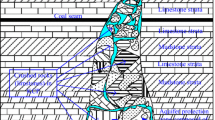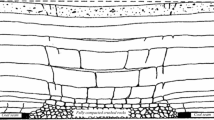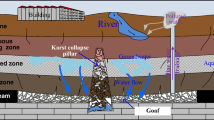Abstract
Karst collapse pillar (KCP) is widespread in North China coalfields, where coal extraction above the Ordovician limestone aquifer is threatened by the abundant supply of water and a very high hydraulic pressure. KCP is composed of rock skeleton and fine fillings, which can be transferred under the effect of water flow, thus KCP usually functions as a channel for groundwater inrush. In order to investigate the mechanism of mining-induced groundwater inrush of KCP which was caused by fine fillings transfer, a self-designed particle transfer permeability testing system was used to test the crushed mudstones’ flow properties, which included fine filling particle transfer rate, porosity increase rate and permeability under the conditions of varying pore pressure, particle size mixture and compaction level (initial porosity). The tests indicate fine fillings transfer is the essential reason for mining-induced groundwater inrush (flow instability) of KCP. The flow properties changeability during fine particle transfer could be divided into four stages, i.e., initial flow stage, flow inrush stage, continued particle flow stage and stable flow stage, and flow inrush stage which is the key point to cause water inrush. Due to the crushing of edges and corners and the adjustment of the structure, the fluctuation of permeability–time relationship mainly distributed in the first two stages, which make a change to flow channel. Moreover, with the increasing of pore pressure, particle size mixture and initial porosity, the water inrush time and stable seepage time decreased more rapidly; the fine fillings, porosity and permeability increased gradually. The efficiency criteria analysis between measurement and calculation permeability shows an empirical equation can fit the relationship between porosity and permeability well, and not all of the pore structures were in flow; this means there was a part of pores that were invalid, but the effective porosity in flow can be treated as calculation value approximately.




















Similar content being viewed by others
References
Aydin A, Borja RI, Eichhubl P (2006) Geological and mathematical framework for failure modes in granular rock. J Struct Geol 28(1):83–98
Bai HB, Ma D, Chen ZQ (2013) Mechanical behavior of groundwater seepage in karst collapse pillars. Eng Geol 164:101–106
Blodgett S, Kuipers JR (2002) Underground hard-rock mining: subsidence and hydrologic environmental impacts. Centre of Science in Public Participation, Bozeman
Blotz LR, Benson CH, Boutwell GP (1998) Estimating optimum water content and maximum dry unit weight for compacted clays. J Geotech Geoenviron Eng ASCE 124(9):907–912
Booth CJ (2006) Groundwater as an environmental constraint of longwall coal mining. Environ Geol 49(6):796–803
Casini F, Viggiani GMB (2011) Experimental investigation of the evolution of grading of an artificial material with crushable grains under different loading conditions. In: Proceedings of the 5th international symposium on deformation characteristics of geomaterials, Seoul, pp 957–964
Casini F, Viggiani GMB, Springman SM (2013) Breakage of an artificial crushable material under loading. Granular Matter 15(5):661–673
Chilingar GV (1964) Relationship between porosity, permeability, and grain-size distribution of sands and sandstones. Dev Sedimentol 1:71–75
Cho G-C, Dodds J, Santamarina JC (2006) Particle shape effects on packing density, stiffness, and strength: natural and crushed sands. J Geotech Geoenviron Eng ASCE 132(5):591–602
Coop MR, Sorensen KK, Freitas TB, Georgoutsos G (2004) Particle breakage during shearing of a carbonate sand. Geotechnique 54(3):157–163
Engelhardt I, Finsterle S (2003) Thermal–hydraulic experiments with bentonite/crushed rock mixtures and estimation of effective parameters by inverse modeling. Appl Clay Sci 23(1–4):111–120
Guo WJ, Liu YX (1989) The concept of water in-rush coefficient and its application. J Hebei Coal 2:56–60 (in Chinese)
Hamdani IH (1983) Optimum moisture content for compacting soils one-point method. J Irrig Drain Eng ASCE 109(2):232–237
Hardin BO (1985) Crushing of soil particles. J Geotech Geoenviron Eng ASCE 111(10):1177–1192
He KQ, Guo D, Du W, Wang R (2007) The effects of karst collapse on the environments in North China. Environ Geol 52(3):449–455
He KQ, Yu GM, Lu YR (2009) Palaeo-karst collapse pillars in northern China and their damage to the geological environments. Environ Geol 58(5):1029–1040
Hu XY, Wang LG, Lu YL, Yu M (2014) Analysis of insidious fault activation and water inrush from the mining floor. Int J Min Sci Technol 24(4):477–483
Huang XW, Tang P, Miao XX, Chen ZQ (2005) Testing study on seepage properties of crushed sandstone. Rock Soil Mech 26(9):1385–1388
Jamei M, Guiras H, Chtourou Y, Kallel A, Romero E, Georgopoulos I (2011) Water retention properties of perlite as a material with crushable soft particles. Eng Geol 122(3–4):261–271
Johnsen Ø, Toussaint R, Måløy KJ, Flekkøy EG, Schmittbuhl J (2007) Coupled air/granular flow in a linear Hele-Shaw cell. Phys Rev E Am Phys Soc 77:011301
Johnsen Ø, Chevalier C, Lindner A, Toussaint R, Clément E, Måløy KJ, Flekkøy EG, Schmittbuhl J (2008) Decompaction and fluidization of a saturated and confined granular medium by injection of a viscous liquid or a gas. Phys Rev E Am Phys Soc 78:051302
Kogure K (1976) Experimental study on permeability of crushed rock. Mem Defense Acad Japan 16(4):149–154
Kong HL, Chen ZQ (2006) Water inrush factor and its application in the analysis on harmfulness of water inrush in the longwall mining in Longgu Coal Mine. J Wuhan Univ Technol 28(9):81–83 (in Chinese and abstract in English)
Kong HL, Miao XX, Wang LZ et al (2007) Analysis on the harmness of water-inrush from the coal seam floor based on the theory of seepage instability. J China Univ Min Technol 17(4):453–458
Kong HL, Chen ZQ, Bu WK et al (2008) A primary exploration on the relationships among loading key strata, water-resisting key strata and seepage key strata. J China Coal Soc 33(5):485–488 (in Chinese and abstract in English)
Krause P, Boyle DP, Bäse F (2005) Comparison of different efficiency criteria for hydrological model assessment. Adv Geosci 5:89–97
Lade PV, Yamamuro JA, Bopp PA (1996) Significance of particle crushing in granular materials. J Geotech Geoenviron Eng ASCE 122(4):309–316
Legrand J (2002) Revisited analysis of pressure drop in flow through crushed rocks. J Hydraul Eng 128(11):1027–1031
Li LJ (1996) Study of water in-rush mechanism, Ph.D. thesis, China University of Mining and Geology, Xuzhou, People’s Republic of China (in Chinese)
Li GY, Zhou WF (2006) Impact of karst water on coal mining in North China. Environ Geol 49:449–457
Li GC, Jiang ZH, Lv CX, Huang C, Chen G, Li MY (2015) Instability mechanism and control technology of soft rock roadway affected by mining and high confined waters. Int J Min Sci Technol 25(4):573–580
Liu GL, Yin SX, Wang YB (2007) Model of water inrush for thick wall cylinder at side face of paleo-sinkholes in north China type coalfields. J Eng Geol 15(2):284–287 (in Chinese and abstract in English)
Liu WQ, Fei XD, Fang JN (2012) Rules for confidence intervals of permeability coefficients for water flow in over-broken rock mass. Int J Min Sci Technol 22:29–33
Lobo-Guerrero S, Vallejo LE (2005) Discrete element method evaluation of granular crushing under direct shear test conditions. J Geotech Geoenviron Eng ASCE 131(10):1295–1300
Lu YL, Wang LG (2015) Numerical simulation of mining-induced fracture evolution and water flow in coal seam floor above a confined aquifer. Comput Geotech 67:157–171
Lu HF, Yao DX, Shen D, Cao JY (2015) Fracture mechanics solution of confined water progressive intrusion height of mining fracture floor. Int J Min Sci Technol 25(1):99–106
Ma D, Bai HB (2015) Groundwater inflow prediction model of karst collapse pillar: a case study for mining-induced groundwater inrush risk. Nat Hazards 76(2):1319–1334
Ma D, Mao XB, Li C, Du F (2012) Boundary integral computation of elastic water resisting key strata under the condition of discontinuous load. CMES Comput Model Eng Sci 83(6):561–574
Ma D, Miao XX, Chen ZQ, Mao XB (2013) Experimental investigation of seepage properties of fractured rocks under different confining pressures. Rock Mech Rock Eng 46:1135–1144
Ma D, Miao XX, Jiang GH, Bai HB, Chen ZQ (2014) An experimental investigation of permeability measurement of water flow in crushed rocks. Transp Porous Media 105:571–595
Ma D, Bai HB, Wang YM (2015a) Mechanical behavior of a coal seam penetrated by a karst collapse pillar: mining induced groundwater inrush risk. Nat Hazards 75(3):2137–2151
Ma D, Bai HB, Chen ZQ, Pu H (2015b) Effect of particle mixture on seepage properties of crushed mudstones. Transp Porous Media 108(2):257–277
Ma D, Miao XX, Bai HB, Huang JH, Pu H, Wu Y, Zhang GM, Li JW (2016a) Effect of mining on shear sidewall groundwater inrush hazard caused by seepage instability of the penetrated karst collapse pillar. Nat Hazards. doi:10.1007/s11069-016-2180-9
Ma D, Bai HB, Miao XX, Pu H, Jiang BY, Chen ZQ (2016b) Compaction and seepage properties of crushed limestone particle mixture: an experimental investigation for Ordovician karst collapse pillar groundwater inrush. Environ Earth Sci 75:11
Margiotta S, Negri S, Parise M, Quarta TAM (2016) Karst geosites at risk of collapse: the sinkholes at Nociglia (Apulia, SE Italy). Environ Earth Sci 75:8
Mateo-Lázaro J, Sánchez-Navarro JA, García-Gil A, Edo-Romero V (2015) A new adaptation of linear reservoir models in parallel sets to assess actual hydrological events. J Hydrol 524:507–521
Miao XX, Liu WQ, Chen ZQ (2004) Seepage theory of mining strata. Science Press, Beijing
Miao XX, Cui XM, Wang JA, Xu JL (2011a) The height of fractured water-conducting zone in undermined rock strata. Eng Geol 120:32–39
Miao XX, Li SC, Chen ZQ, Liu WQ (2011b) Experimental study of seepage properties of broken sandstone under different porosities. Transp Porous Media 86:805–814
Niebling M, Toussaint R, Flekkøy EG, Måløy KJ (2012) Dynamic aero fracture of dense granular packings. Phys Rev Am Phys Soc 86:061315
Peng SP, Zhang JC (2007) Engineering geology for underground rocks. Springer, Berlin
Pradip KGN, Venkataraman P (1995) Non-Darcy converging flow through coarse granular media. J Inst Eng Civil Eng Div 76:6–11
Qian MG, Liu TC (1983) Ground pressure and strata control in mine. Coal Industry Press, Beijing (in Chinese)
Qian MG, Miao XX, Xu JL, Mao XB (2003) Key strata theory for control of strata movement. Press of China University of Mining and Technology, Xuzhou (in Chinese)
Singh MM (1992) Mine subsidence. In: Hartman HL (ed) SME mining engineering handbook. Society for Mining Metallurgy and Exploration Inc., Littleton, Colorado, pp 938–971
Sun MG, Li TZ, Huang XW (2005) Mechanism of water inrush based on the instability of the seepage flow in rock strata. J China Univ Min Technol 34(3):284–288 (in Chinese and abstract in English)
Wang JA, Park H (2003) Coal mining above a confined aquifer. Int J Rock Mech Min Sci 40(4):537–551
Wang LG, Song Y (2002) A catastrophic model of water-inrush from coal floor. J Eng Geol 2:160–163 (in Chinese and abstract in English)
Wang J-J, Zhang H-P, Tang S-C, Liang Y (2013a) Effects of particle size distribution on shear strength of accumulation soil. J Geotech Geoenviron Eng ASCE 139(11):1994–1997
Wang JJ, Zhang HP, Deng DP, Liu MW (2013b) Effects of mudstone particle content on compaction behavior and particle crushing of a crushed sandstone–mudstone particle mixture. Eng Geol 167:1–5
Wu Q, Zhou WF (2008) Prediction of groundwater inrush into coal mines from aquifers underlying the coal seams in China: vulnerability index method and its construction. Environ Geol 56:245–254
Wu Q, Wang M, Wu X (2004) Investigations of groundwater bursting into coal mine seam floors from fault zones. Int J Rock Mech Min Sci 41:557–571
Wu Q, Xu H, Pang W (2008a) Advances and challenges of GIS and DBMS applications in karst. Environ Geol 54(5):937–943
Wu Q, Xu H, Pang W (2008b) GIS and ANN coupling model: an innovative approach to evaluate vulnerability of karstwater inrush in coalmines of North China. Environ Geol 54:937–943
Wu D, Hu Y, Fan X (2009) Visual simulation for granular rocks crush in virtual environment based on fractal geometry. Simul Model Pract Theory 17(7):1254–1266
Wu Q, Liu YZ, Liu DH, Zhou WF (2011a) Prediction of floor water inrush: the application of GIS-Based AHP vulnerable index method to Donghuantuo coalmine, China. Rock Mech Rock Eng 44:591–600
Wu Q, Xing LT, Ye CH, Liu YZ (2011b) The influences of coal mining on the large karst springs in North China. Environ Earth Sci 64:1513–1523
Yao BH, Wei JP, Wang DK, Ma D, Chen ZQ (2013) Numerical study of seepage property of karst collapse columns under particle migration. CMES Comput Model Eng Sci 91(2):81–100
Yin SX, Zhang JC (2005) Impacts of karst paleo-sinkholes on mining and environment in northern China. Environ Geol 48:1077–1083
Yin SX, Zhang JC, Liu DM (2015) A study of mine water inrushes by measurements of in situ stress and rock failures. Nat Hazards 79(3):1961–1979
Zhang JC (2005) Investigations of water inrushes from aquifers under coal seams. Int J Rock Mech Min Sci 42:350–360
Zhang JC, Shen BH (2004) Coal mining under aquifers in China: a case study. Int J Rock Mech Min Sci 41:629–639
Zhang JC, Zhang YZ, Liu TQ (1997) Fluid flow in rock mass and water in-rush through coal seam floor. Geology Press, Beijing (in Chinese)
Zhu WC, Wei CH (2011) Numerical simulation on mining-induced water inrushes related to geologic structures using a damage-based hydromechanical model. Environ Earth Sci 62:43–54
Zhu QH, Feng MM, Mao XB (2008) Numerical analysis of water inrush from working face floor during mining. J China Univ Min Technol 18(2):159–163
Zoback MD, Byerlee JD (1976) Note on the deformational behavior and permeability of crushed granite. Int J Rock Mech Min Sci Geomech Abstr 13(10):291–294
Acknowledgments
This work was supported by the National Basic Research Program of China (2013CB227900 and 2015CB251601), the National Natural Science Foundation of China (U1261201, 51322401, 51421003, 51574228 and 51504243), the National High Technology Joint Research Program of China (2012BAB13B00), the 111 Project of China (B07028), the Basic Research Program of Jiangsu Province (BK20130051 and BK20150191), and the Fundamental Research Funds for the Central Universities (2014YC09 and 2014ZDPY08).
Author information
Authors and Affiliations
Corresponding authors
Rights and permissions
About this article
Cite this article
Ma, D., Miao, X., Bai, H. et al. Impact of particle transfer on flow properties of crushed mudstones. Environ Earth Sci 75, 593 (2016). https://doi.org/10.1007/s12665-016-5382-2
Received:
Accepted:
Published:
DOI: https://doi.org/10.1007/s12665-016-5382-2




